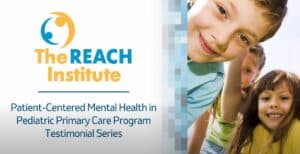Using CBT to Support Pediatric Patients with Depression
- March 27, 2025
- The REACH Institute
- Cognitive behavioral therapy, Depression

“As primary care providers, we can help our pediatric patients with depression using basic Cognitive Behavioral Therapy (CBT) tools,” explains pediatrician and REACH faculty member Jackie Cotton, MD. “Many common recommendations currently used align with CBT best practices. As part of an evidence-based treatment protocol, a clear roadmap for using these tools helps clinicians save time and be more effective.”
Research indicates that CBT should play a central role in managing pediatric depression. A landmark randomized controlled trial demonstrated that CBT in combination with a selective serotonin reuptake inhibitor (SSRI) is by far the most effective treatment for adolescent depression, both in short- and long-term outcomes. Further research has also shown that CBT is the most effective evidence-based treatment for adolescent suicidal ideation because it teaches coping skills.
The shortage of pediatric therapists and psychiatrists, including those specializing in CBT, remains a significant barrier to access. To help fill this gap, Dr. Cotton partnered with REACH to create a new, one-day CBT for Depression in Pediatric Primary Care course for primary care providers (PCPs).
Here, Dr. Cotton walks us through the core elements of using CBT to help pediatric patients struggling with depression.
The Basics of CBT for Depression
“Cognitive behavioral therapy is about the relationship between thoughts, feelings, and behaviors,” explains Dr. Cotton. CBT skills enable patients to disrupt negative patterns across these three areas, leading to significant and lasting improvements.
There are five core elements of using CBT for pediatric depression:
- Psychoeducation: Hope is the most important part of psychoeducation. Clinicians can reassure patients that depression is common but not normal and that it is treatable. When patients have a better understanding of their disorder and the ways CBT can help, they are more empowered to use the skills.
- Behavioral activation: In practical terms, behavioral activation means getting patients to “do stuff” that will improve their mental state. For example, when clinicians suggest that patients with depression take a daily walk outside to improve their mood, this is behavioral activation.
- Coping strategies: Clinicians can help patients prepare for managing future moments when they feel overwhelmed by negative emotions. Dr. Cotton advises patients to practice their chosen coping strategies, such as deep breathing or progressive muscle relaxation, at bedtime each day to make it easier to call on when needed.
- Problem-solving: When a situation contributing to a patient’s depression can be changed, clinicians can help the patient work through practical problem-solving. For example, if a teen is overwhelmed by taking too many AP classes, they may be able to change their schedule and remove that stressor.
- Cognitive reframing: Clinicians can help patients reframe negative thoughts or even put the thoughts “on trial.” For example, if a depressed teen is struggling after a breakup, they may be caught up in thought patterns like: “No one wants to be with me; I’m not loveable.” The clinician could encourage the teen to put those thoughts on trial by asking, “What’s the evidence for and against the thought that you’re unlovable?”
Dr. Cotton shares that PCPs have a unique advantage when using these CBT tools with pediatric patients. “We know our patients well, so we can help them find ways to change their thoughts and behaviors that are very specific and meaningful.”
Unlike a medication, CBT is a skill that remains with the patient long-term. If depression recurs, patients can turn to the same CBT skills that helped them the first time.
Integrating CBT for Depression into a Busy Practice
While many PCPs naturally use recommendations like behavioral activation in their practices, the REACH course offers clinicians a straightforward, evidence-based approach to using CBT strategically and intentionally.
“In primary care, kids come in with belly pain all the time,” says Dr. Cotton. “I have a mental roadmap for that: I know the things I need to ask and do. This course offers a roadmap for helping kids with depression.”
As one participant in the first session of the CBT for Depression in Pediatric Primary Care course shared: “This is immediately actionable and evidence-based. I feel confident that I could help my patients starting Monday with this material! I feel comfortable either managing or being a bridge for my patients with depression with these skills.”
RESOURCES:
- The Treatment for Adolescents with Depression Study (TADS) was a randomized controlled trial that demonstrated that the most effective treatment protocol for adolescent depression was a combination of SSRI medication (fluoxetine) and CBT. Suicidal events were also less likely in patients receiving CBT alone or CBT and medication combination therapy.
- Click here to learn more and register for CBT for Depression (CBT-D) in Pediatric Primary Care. You can also join the CBT-D waitlist and be notified as new course dates become available.
Categories
- ADHD
- Anti-racism
- Anxiety
- Assessment & screening
- Autism
- Child mental health
- Coding
- Cognitive behavioral therapy
- College transition
- Culturally responsive
- Depression
- Eating disorders
- Foster care
- Grief
- High-risk children & youth
- LGBTQIA
- Medication
- Parents
- Patient communication
- Pediatric primary care
- School refusal
- Sleep disorders
- Suicide
- Trauma
- Show All Categories
Register for courses
“The REACH Institute Video Testimonial: Jasmin  ”
”
